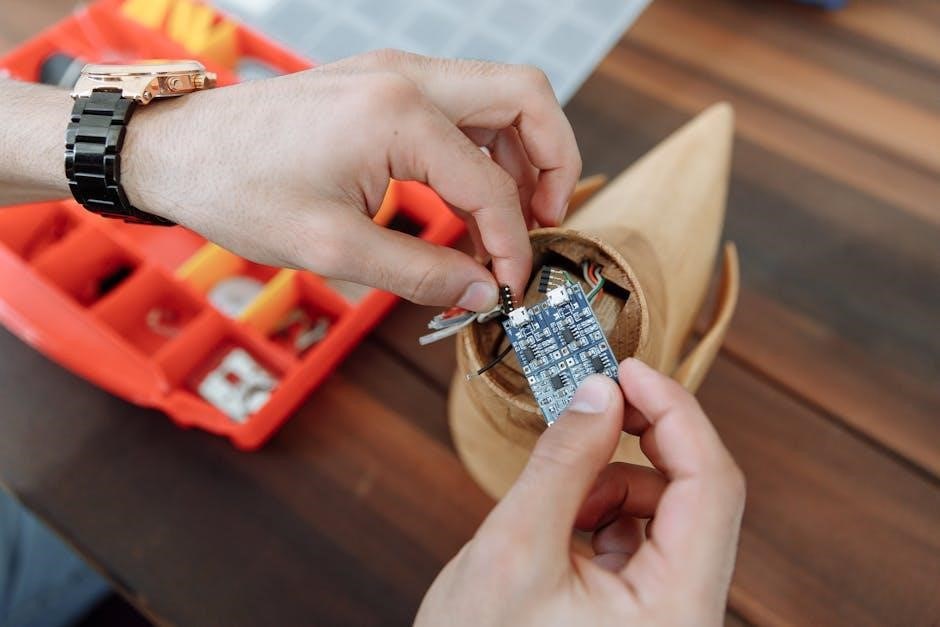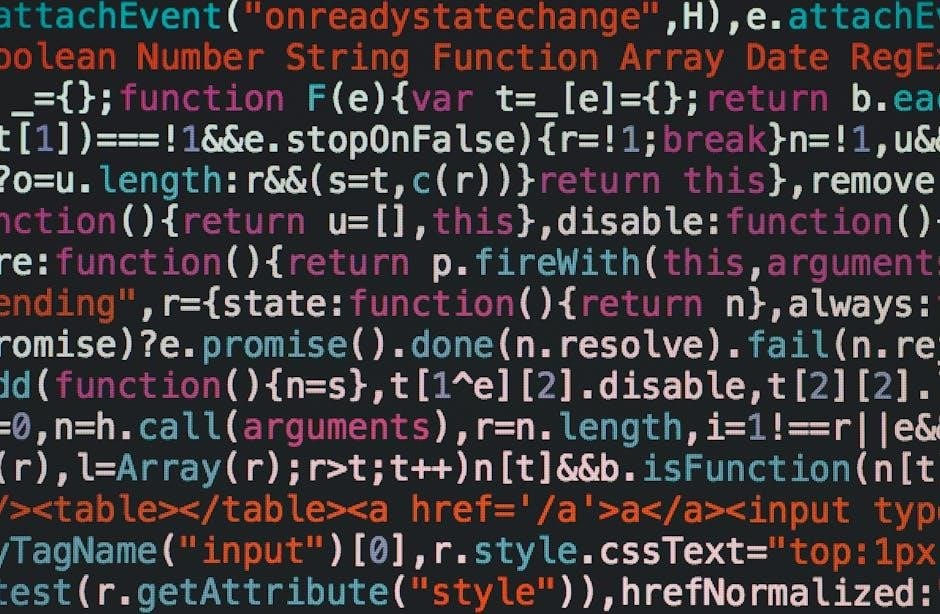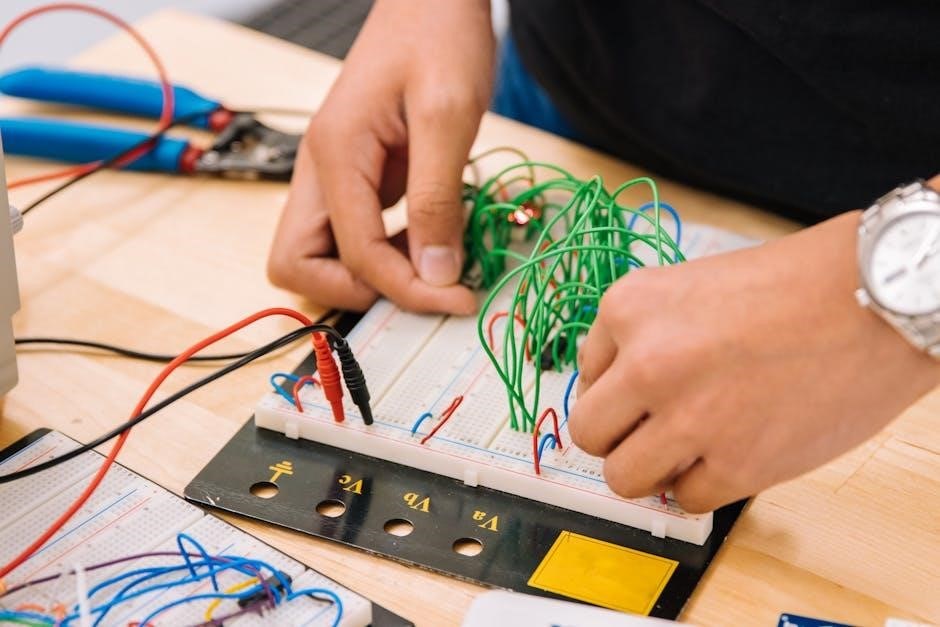Renishaw Probe Programming Manual PDF: A Comprehensive Guide
Unlock the full potential of your Renishaw probing system with our comprehensive guide to programming manuals in PDF format. These manuals are essential resources for users of HAAS VF series machines. They offer guidance for probe installation, setup, and programming, ensuring efficient and accurate operation.
Renishaw probing systems are integral to modern CNC machining, offering high-precision measurement and inspection capabilities. These systems enhance automation by enabling on-machine verification of part dimensions and tool conditions. Renishaw probes are known for their accuracy and reliability, crucial for achieving tight tolerances in manufacturing.
The integration of Renishaw probes into CNC machines simplifies complex measurement processes. By using probing cycles, operators can quickly and accurately set work offsets, inspect finished parts, and detect tool wear. This reduces the need for manual intervention, minimizing errors and maximizing productivity.
Renishaw’s probing solutions also support adaptive machining strategies. The system can automatically adjust machining parameters based on real-time measurements, ensuring consistent part quality. Understanding the programming behind these probes is essential for optimizing machining operations and leveraging the full capabilities of Renishaw systems.
Properly programmed and calibrated Renishaw probes contribute to a more efficient manufacturing process, reducing scrap and rework. The availability of comprehensive programming manuals in PDF format ensures that users can effectively utilize these advanced tools.
Availability of Renishaw Manuals
Accessing Renishaw manuals is crucial for effectively utilizing their probing systems. Renishaw provides a wide range of manuals in PDF format, covering installation, programming, and maintenance of their products. These manuals are essential for users seeking to optimize their CNC machining processes and ensure accurate measurements.
The manuals are typically available for download from the Renishaw website or through authorized distributors. These resources provide comprehensive guidance on various aspects of Renishaw probes, including setup procedures, programming examples, and troubleshooting tips. Users can easily find the specific manual that corresponds to their probe model and CNC controller.
Furthermore, Renishaw’s technical support library offers additional documentation and resources for machine tool probes. This includes technical documentation, repair manuals, and user guides for specific applications. The availability of these manuals ensures that users have the necessary information to operate and maintain their Renishaw probing systems effectively.
By providing detailed manuals in PDF format, Renishaw empowers users to maximize the performance and longevity of their probing equipment. These resources are invaluable for both new and experienced users seeking to enhance their machining capabilities.
Renishaw Probe Installation and Setup
Proper installation and setup are critical for the accurate and reliable operation of Renishaw probes. The Renishaw manuals provide detailed instructions on how to install and configure the probes for specific CNC machine tools. These manuals cover various aspects of the installation process, including mechanical mounting, electrical connections, and software configuration.
The installation manuals offer step-by-step guidance on connecting the probe system to the CNC controller. They also provide information on switch settings, connector types, and signal specifications. Engineers involved in installation, support, or upgrade activities will find this information particularly useful.

Furthermore, the manuals emphasize the importance of following the recommended procedures to ensure optimal performance. They also caution against modifying the product in any manner that is not specifically described in the product or in the installation or programming manuals.
By adhering to the instructions provided in the Renishaw manuals, users can avoid potential issues and ensure that their probes are installed and set up correctly. This will lead to more accurate measurements, reduced downtime, and improved overall machining efficiency. Proper installation is key to maximizing the benefits of Renishaw probing systems.
Probe Software and Programming Resources
Renishaw provides a wealth of software and programming resources to support the use of its probing systems. These resources include programming manuals, software packages, and technical documentation designed to help users effectively program and operate their probes. These manuals offer comprehensive instructions for probe installation, setup, and programming, ensuring efficient and accurate operation.
The programming manuals provide detailed information on the available probing cycles and commands. They also offer guidance on how to integrate probe routines into CNC programs. Users can leverage these resources to create custom probing routines tailored to their specific application needs.
Renishaw also offers software packages that simplify the programming process. These packages provide user-friendly interfaces and pre-defined probing cycles. These tools enable users to quickly create probing programs without extensive programming knowledge.
In addition to manuals and software, Renishaw provides a technical support library with a vast collection of resources, including application notes, troubleshooting guides, and FAQs. This library serves as a valuable resource for users seeking assistance with probe programming and operation. By utilizing these resources, users can optimize their probing processes and achieve the highest possible accuracy and efficiency.
Understanding Probe Positioning and Code Implementation
Accurate probe positioning is crucial for reliable measurement results. This involves understanding how to program the machine tool to move the probe to the desired location relative to the workpiece. The programming manuals provide detailed guidance on probe positioning techniques, including the use of G-codes and M-codes to control machine tool movements.
The code implementation section covers the specific syntax and structure of probe commands and routines. These commands initiate the probing process, acquire measurement data, and store the results for further analysis. It is essential to understand how to properly implement these commands within the CNC program.

The manuals often include examples of probe routines. These examples demonstrate how to integrate probe commands into a complete program. By studying these examples, users can gain a better understanding of how to implement probe routines in their own applications. Furthermore, the programming manuals detail how to add manual entries to position the probe.
Proper probe positioning and code implementation are critical for accurate and reliable measurements. The Renishaw programming manuals offer comprehensive guidance on these topics, enabling users to effectively utilize their probing systems.
Technical Support and Documentation for Renishaw Probes
Renishaw provides extensive technical support and documentation to assist users with their probing systems. This includes access to a comprehensive technical support library containing a wealth of information on probe installation, operation, and troubleshooting.
Technical documentation for machine tool probes is readily available. It covers various aspects of probe technology, including probe calibration, error compensation, and best practices for achieving accurate measurements.
Users can find repair manuals for specific probe models, providing detailed instructions on how to perform repairs and maintenance. OEM GoProbe iHMI documentation for Fanuc NC systems is also available, offering guidance on integrating Renishaw probes with Fanuc controllers.
Installation and user guides are provided for high precision arms (HPA), detailing the setup and operation of these systems. Furthermore, Renishaw offers live demonstrations of its latest products at events around the world and online, providing users with opportunities to learn about new technologies and applications.
This robust support system ensures that users have access to the resources they need to effectively utilize their Renishaw probes.

Renishaw NC1 Programming Manual Overview
The Renishaw NC1 programming manual is an essential guide for users of the NC1 non-contact tool setting system. This manual provides comprehensive instructions on how to program and operate the NC1 system for accurate tool measurement on machining centers.

The manual covers various aspects of NC1 programming, including the use of measuring subroutines for tool length and diameter setting, cutting edge checking, and broken tool detection. It details the features of the NC1 system software, such as measuring, calibration, and service subroutines.
The manual outlines the software memory requirements and supported machine tool controllers, including Siemens 810D, Siemens 840D, and Siemens FMNC. It also describes the tool-offset types supported, focusing on positive tool-offset applications.
The installation process is explained, along with guidance on customizing subroutines for specific needs. The manual provides detailed information on setting-data subroutines, including parameter descriptions and default values.
The orientation of the NC1 system and the principles of beam-find and measuring moves are thoroughly covered. The manual also addresses scatter tolerance checking and beam alignment procedures.

This overview highlights the key topics covered in the NC1 programming manual, ensuring users can effectively utilize the NC1 system.
GoProbe Cycles for Contact Tool Setting
Renishaw’s GoProbe cycles offer an intuitive approach to contact tool setting, especially for users new to the process. These cycles simplify tool setting through single-line commands, making it easy to implement on CNC machines. The programming manual provides detailed information on using GoProbe for Siemens controls.

GoProbe cycles enable users to quickly set tool length and diameter, reducing setup time and improving machining accuracy. The manual includes explanations of each cycle, along with examples of how to implement them in your CNC programs. This helps in achieving precise tool measurements.
The GoProbe manual covers essential aspects such as defining tool parameters, specifying measurement positions, and setting tolerance values. It also includes troubleshooting tips to address common issues encountered during tool setting. By following the guidelines in the manual, users can optimize the performance of their Renishaw probes.
The manual provides step-by-step instructions for each GoProbe cycle, making it easy to understand and implement. It also explains how to integrate GoProbe cycles with existing CNC programs. This ensures seamless tool setting operations. With GoProbe, users can achieve consistent and reliable tool measurements, improving overall machining quality.
Warranty and Product Replacement Information

Renishaw provides a warranty for its products, ensuring they perform to specification under proper use. If a product fails to meet specifications within 90 days of delivery, Renishaw will replace or repair it. This warranty does not cover modifications not described in the product or programming manuals.
The warranty is valid only if the product has been used according to the guidelines in the installation and programming manuals. It is essential to follow these instructions to avoid voiding the warranty. Renishaw is not liable for issues arising from improper use or unauthorized modifications.
For product replacements, customers should contact Renishaw or an authorized distributor. A return merchandise authorization (RMA) number may be required. Proof of purchase and a detailed description of the issue are necessary for processing the replacement.

Renishaw’s warranty aims to provide customers with confidence in their products. By adhering to the recommended usage and maintenance practices, users can ensure long-term performance. The company is committed to addressing product defects and providing timely replacements when necessary.
Please refer to the complete warranty documentation provided with your product for detailed terms and conditions. This information outlines the scope of coverage and any limitations that may apply. Understanding the warranty is crucial for protecting your investment.
Switch and Connector Guide for Renishaw CMM Products
This guide provides comprehensive information on switches, connectors, and signals of conventional Renishaw interfaces and controllers used in Coordinate Measuring Machines (CMMs). It serves as an essential resource for engineers involved in installation, support, or upgrade activities associated with Renishaw CMM products.
Understanding the functionality of switches and the configuration of connectors is crucial for ensuring proper communication between CMM components. This guide details the purpose of each switch, describing its role in controlling various aspects of the CMM system, such as probe triggering, data acquisition, and safety mechanisms.
The guide also provides detailed pinout diagrams for various connectors, illustrating the signals carried by each pin. This information is invaluable for troubleshooting connection issues and ensuring the correct wiring configurations during installation or maintenance. It covers both analog and digital signals, offering a complete overview of the CMM’s electrical interface.
Furthermore, the guide includes information on common connector types used in Renishaw CMM products, such as D-sub connectors, circular connectors, and specialized interface connectors. Each type is described in detail, along with its typical applications within the CMM system.
By consulting this guide, engineers can quickly identify and resolve issues related to switches and connectors, minimizing downtime and ensuring the accurate and reliable operation of Renishaw CMMs. It is a vital reference for anyone working with these sophisticated measurement systems.
Calibration of Measurement Probes
Calibration is a critical process to ensure the accuracy and reliability of measurement probes. It involves determining and correcting systematic errors inherent in the probe system, thereby improving the precision of measurements. This section details the importance of probe calibration and outlines the essential steps involved.
The primary reason for calibrating measurement probes is to compensate for variations in probe geometry, stylus dimensions, and machine tool characteristics. These factors can introduce errors that, if left uncorrected, can significantly affect measurement results; Calibration establishes a reference point, allowing the system to accurately determine the position of the probe tip relative to the machine coordinate system.
The calibration process typically involves measuring a known artifact, such as a calibration sphere or a precision gauge block, at multiple points. The measured data is then compared to the artifact’s known dimensions, and any discrepancies are used to calculate correction factors. These correction factors are applied to subsequent measurements, effectively eliminating systematic errors.
The frequency of calibration depends on various factors, including the probe’s usage, environmental conditions, and the required measurement accuracy. Regular calibration is essential to maintain the probe’s performance and ensure that measurements remain within acceptable tolerances. Chapter 6 of the manual contains details of the macros used to calibrate Renishaw probes.
By following proper calibration procedures, users can achieve the highest possible accuracy from their Renishaw measurement probes, ensuring reliable and trustworthy measurement results.
NC1 Non-Contact Tool Setting System Programming Guide
This section delves into the programming aspects of the Renishaw NC1 non-contact tool setting system. The NC1 is a laser-based system designed for high-speed and high-precision measurement of cutting tools on machining centers, operating under normal conditions. This guide describes how to use the Renishaw NC1 non-contact tool setting system software.
The programming guide provides comprehensive instructions on utilizing the NC1 system software, which includes measuring and calibration features. It covers essential measuring subroutines like L9862, used for determining tool length and diameter, as well as cutting edge checking. The guide also details service subroutines such as L9760 for settings data and L9761 for startup functions.

Understanding the software’s memory requirements and compatibility with various machine tool controllers, including Siemens 810D, 840D, and FMNC, is crucial. The guide clarifies the tool-offset types supported, emphasizing positive tool-offset applications. It also provides insights into installing the software and customizing subroutines for optimal performance.
The NC1 system software offers features like scatter tolerance checking and beam alignment, enhancing measurement accuracy. This programming guide serves as a valuable resource for users seeking to maximize the capabilities of their Renishaw NC1 system, ensuring precise and efficient tool setting operations.
The document specifically disclaims any implied warranties.